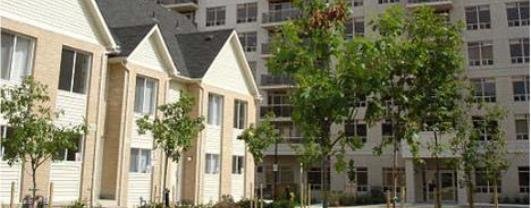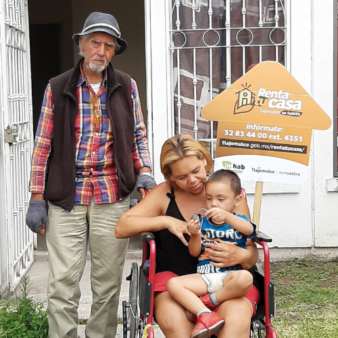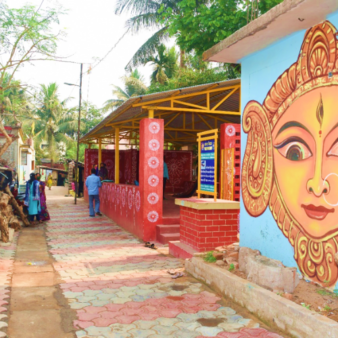Established in 1998, Home Ownership Alternatives (HOA) is a non-profit financial corporation operating in Greater Toronto which finances the development of affordable ownership housing. It uses a range of innovative financial mechanisms, including shared appreciation second mortgages, to enable low and moderate income families become home owners. Working with development partners, HOA has supported 11 housing developments providing 2,350 homes to date. A range of housing types are provided including apartments, duplexes and townhouses, all of which are more affordable to those families who fall in the gap between social housing provision and conventional home ownership provision.
Project Description
Aims and Objectives
HOA finances the development of affordable ownership housing and thus assists in the development of sustainable mixed communities. Through its work it seeks to create homes and not speculative instruments.
Programme context
Toronto is the largest city, financial capital and a hub of economic activity and prosperity in Canada, but it has a significant shortage of affordable housing. To purchase a home, most families need an annual income greater than US$ 75,000.The conventional housing development industry only meets the needs of high income households and 187,000 households in Toronto spend more than 30 per cent of their income on housing. The only way to own a house is by making a substantial down payment and taking on a large mortgage. The down payment is usually achieved with help from family and friends and each successive wave of homebuyers is taking on increasing levels of debt.
Political changes in the 1990s compounded the housing problems, with responsibility for housing transferred from provincial to municipal government and a severe cut-back in federal and provincial funding for the construction of new social housing and the provision of rental subsidies. Construction of new social housing was discontinued as municipalities focussed their attention on meeting the operating costs of their existing housing stock and supporting low income households from the municipal tax base. The substantial group of people of low to moderate incomes who are not eligible for social housing but who cannot afford to buy their own homes are the most affected. These people have little option other than to rent in the private sector, which can take a significant part of their income.
Key features
HOA supports housing developments that cost 10 to 15 per cent less than the low-end-of-market price. It does this through two main areas of activity – providing early financing loans to development partners who carry out the construction and providing shared appreciation second mortgages to low and moderate income purchasers of the properties. Approximately 16 per cent of HOA’s lending in 2007 was to developers (US$2,172,000) and 84 per cent to purchasers (US$11,760,000).
Seventy five per cent of the programme beneficiaries have income below the Toronto median of US$53,000. Many purchasers are key workers and HOA is currently looking to partner with police, health and education organisations to increase this. The programme does not seek to help rough sleepers or those begging on the streets, but aims to assist those earning low incomes.
HOA lends its development partners relatively risky early stage funding to assist with feasibility studies, land acquisition and early marketing and sales. This normally covers 50 per cent of these costs, at interest of one per cent above prime rate, normally repayable on the date of construction financing. HOA works with like-minded development partners committed to providing affordable home ownership and by using comprehensive loan review criteria it has a high rate of successful projects and repayments. Development partners are able to achieve lower construction costs by purchasing residential land that is cheaper than land used for private condo developments, reducing advertising costs and eliminating expensive amenities, model suites and sales commissions. The purchasing family must finance (through a downpayment and conventional first mortgage) the cost of development and there is no profit for the developer, with its income derived from a fee, charged in the same way as other construction professionals. The difference between unit cost and market price is captured in the HOA second mortgage. Early marketing is important as construction financing from the banks in Canada is not available until at least 60 per cent of all properties have been sold off plan. Virtually all of HOA properties are sold off-plan. All marketing, design and planning of the housing development is carried out by the development partners (to local neighbours in the first instance) and not by HOA. The latter’s role is primarily to provide the enabling financial mechanism.
Financial support is provided to homebuyers through the provision of shared appreciation second mortgages. This basic second mortgage is the difference between the unit’s costs to develop and build and its market value. On average it accounts for 10 to 15 per cent of the total purchase price. It reduces the amount the household needs to finance as it is recognised by first mortgage lenders and treated as equity in their calculations. The homeowners pay no principal or interest on the second mortgage until they sell the home (or earlier if they chose to).
If additional cash funds are needed to ensure affordability, the second mortgage may be increased with additional cash funds from HOA, government or other funding sources, such as the June Callwood Fund. When a household pays off the second mortgage and the associated interest, the money goes back into the HOA revolving fund, allowing it to finance more developments. A shared appreciation mortgage does not bear a specific rate of interest but rather it earns interest at a rate equal to any increase in the value of the home. HOA only offers these second mortgages to those who intend to live in the home and this mortgage needs to be repaid if the owner rents out the property. For example: The total development cost of a unit is $130,000 and the market value is $155,000. Purchasers are required to provide a five per cent minimum down payment of the market value, i.e. $7,750 and the balance of $122,250 is obtained from a bank at normal lending rates. The difference of $25,000 is held as an interest-free second mortgage. As $25,000 is 16.1 per cent of the total value of the unit, when the unit is sold on the open market 16.1 per cent of the sale price will go to HOA. So, for example, if the unit is sold for $200,000, $32,200 will go to HOA, of which $25,000 is repayment of the principle and $7,200 is the interest payment. The household’s equity will have increased by at least $37,800 (more if you include the principal repaid on the first mortgage). In the event of a reduction in value on resale, the value of the second mortgage is forgiven. Only when the loss of value falls below this does the owner make a loss.
This is not a sub-prime product as HOA requires that purchasers prove credit worthiness by qualifying for a first mortgage from a major bank and have a minimum of five per cent down payment. Purchaser families dedicate no more than 32 per cent of their income to total housing costs. A survey of the latest 800 people housed shows that 11 per cent had incomes of below US$24,000, 65 per cent had incomes between US$24,000 and US$49,000, 18 per cent had incomes between US$49,000 and US$74,000 and six per cent had incomes over US$74,000. Those on higher incomes are only entitled to the basic HOA second mortgage, not to any additional top-ups.
Covering costs
Funding is primarily from HOA’s own resources, although in some instances the federal, provincial and municipal government have provided additional subsidies alongside the HOA second mortgage to increase the affordability even further.
The initial capital for HOA was established when the non-profit developer, Options for Homes, assigned the profit in the form of second mortgages from the St Lawrence development in 1998 to the newly established HOA. Repayments of these second mortgages when people moved or chose to repay created this initial fund. Interest payments from developers on their loans added to it. Payments from both the developers and the purchasers go back into a revolving fund and can be used to assist the development of further affordable units.
Bank lending is currently restricted as in many other countries, but HOA has good links with the credit unions which are prepared to fund its activities. In December 2008 a consortium of credit unions provided US$77m for construction financing. HOA is also entitled to apply for construction financing from anew government agency, Infrastructure Ontario.
Impact
- To date, 2,530 low to moderate-income households have become homeowners. The average HOA property is priced at US$143,000. Many owners pay less in mortgage than their previous rental payments and are thus in a better financial position than before.
- Compared to other affordable housing models, HOA has successfully produced large numbers of units at relatively low cost and overhead.
- Research shows that owner occupation brings improved health, positive education outcomes, community pride and reduction of poverty. There is consistent anecdotal evidence from home owners about the improvements in their lives.
- One measure of the longer term success is the low default rate of below one per cent over the last ten years.
- Governments and other organisations are increasingly coming to work with and fund HOA and examine the model.
Why is it innovative?
- The combined approach of low-cost housing development and low-income mortgage financing, which HOA has pioneered together with the Options for Homes developer.
- Use of the shared appreciation mortgage mechanism to facilitate the extension of home ownership opportunities to lower income families through the creation of a revolving fund.
- Provision of accommodation for a range of incomes, although with a majority of the units being for those on low incomes.
What is the environmental impact?
- Local materials and labour are used wherever possible for construction of the dwellings. There is a high level of environmental specification, exceeding the industry standards. Additional features include solar thermal heating, energy recovery systems, individual water metering, waste sorting/recycling, air filtration and integrated energy management.
- Fewer parking spaces are needed in mixed income developments and this encourages greater use of public transport and in the most recent development, car sharing on site was offered to reduce the need for car ownership and usage.
- Most HOA projects are infill projects in urban locations in close proximity to public transportation and many of these are on brownfield sites, thereby helping reduce urban sprawl and commute times.
Is it financially sustainable?
HOA has created a self-sustaining permanent revolving fund. This has increased in value over time to US$24 million and is anticipated to increase to US$40 million by 2011 as second mortgage repayments continue to be made. Recent falls in house prices in Canada have had very little impact on HOA activities as there has been very little movement in price of those developments that are positioned at the very low end of the market. HOA is serving an underserved segment of the housing market, where there is excess demand for the properties; the HOA substantial down payment is very attractive and lower market prices reduce only the rate at which the pool of reinvestment capital can grow. It does not impact on HOA’s viability. The government has loaned US$6,500,000 in additional second mortgage support to further assist those on the lowest incomes.
HOA’s greatest risk, if any, lies with projects under construction where HOA has invested financing and not all buyers may be able to close if the economic turmoil and downturn continue. However, the next building under development is not scheduled to close until late 2011 and 604 of the 643 units have already been pre-sold at very competitive prices.
HOA supports developers who are able to build homes that are 10 to 15 per cent cheaper than the lowest priced properties on the market. The buildings do not include expensive amenities (swimming pools, gyms), thereby reducing monthly maintenance fees.
What is the social impact?
Disparities in wealth have created very rich and very poor communities in Toronto which do not interact. HOA has helped to develop sustainable mixed communities where a range of incomes can live in the same neighbourhood. All HOA developments include a common room that can be used for meetings, social gatherings etc. Community involvement is central to the programme. It is a collaborative work of the municipality, local not-for-profit developers and community members to ensure that the housing developed is appropriate to the scale and style of the community. The local community is invited to meetings to participate in the early planning and development stages of the project and is particularly interested in the design and appearance of the building. This process helps to ensure that the developments receive overwhelming community support and helps to address the NIMBY (Not In My Back Yard) issues.
A cooperative development corporation is created to develop the apartment block and all homeowners automatically become members of the cooperative and are involved with the decision-making in respect of final design and amenities. A condominium corporation is created at sales closing as the onongoing ownership structure.
Barriers
- Policy constraints with less government support provided than to rental housing, i.e. there are no tax concessions or accelerated permit approvals. Development charges are also levied by unit size rather than selling price.
- Community resistance to affordable housing (NIMBYism) because of its reputation for concentrating poverty and crime. HOA and the development partners approach this by ensuring that those renting locally have the opportunity to become owners. By engaging with the local community at an early stage much of the resistance can be overcome.
- Early stage financing for non-profit developers was virtually non existent.
- Non-profit developers could not afford to land bank in anticipation of rising prices.
- The deeply entrenched attitude amongst policy makers and social activists that affordable housing means rental housing.
Lessons Learned
- Low-income purchasers can make substantial down payments and these can be significant to development financing.
- Affordable homes for ownership can be built without government subsidy.
- A dollar committed to ownership housing will yield more units than a dollar committed to rental housing.
- Low and moderate income households can afford to own their own homes.
- Affordable home ownership increases the net worth of families and the earlier someone owns a home the better for the financial position.
- Ownership is more important for lower income households because it transforms their largest household expense into a long-term family equity, creating investment.
- Concentration of assistance on the most needy is more effective than small amounts of assistance spread across many purchasers.
- Changes to government policies would greatly assist the effort at little cost to government.
Evaluation
The Canadian Urban Institute was commissioned to carry out a study of HOA’s activities, analysing one particular development in detail to identify the benefits accruing to the low income owners. The results of this study have been published.
Transfer
HOA continues to develop new projects in Ontario and currently has a further 720 units under development. It hopes to develop 1,000 new units each year. It has successfully partnered with federal, provincial and municipal governments and has also been appointed as a delivery agent for the City of Toronto to deliver affordable ownership housing under the Canada-Ontario Affordable Housing Program.
Models similar to HOA’s are beginning to be used locally and elsewhere in Canada, for example, Wood Buffalo Housing in northern Alberta has sold homes that it has built with a second mortgage. In Montreal the Societe d’Habitation et de Developpement de Montreal (SDHM) combined the development principles of Options for Homes and some aspects of HOA’s financing innovation with its larger social housing organisation to create Access Condos, Montreal’s largest affordable housing developer. HOA is currently looking at how for-profit developers can be involved in the model to further increase its transfer. HOA has also expressions of interest in its model from South Africa, Namibia, Senegal, Uganda, Jamaica, Romania and Viet Nam.



